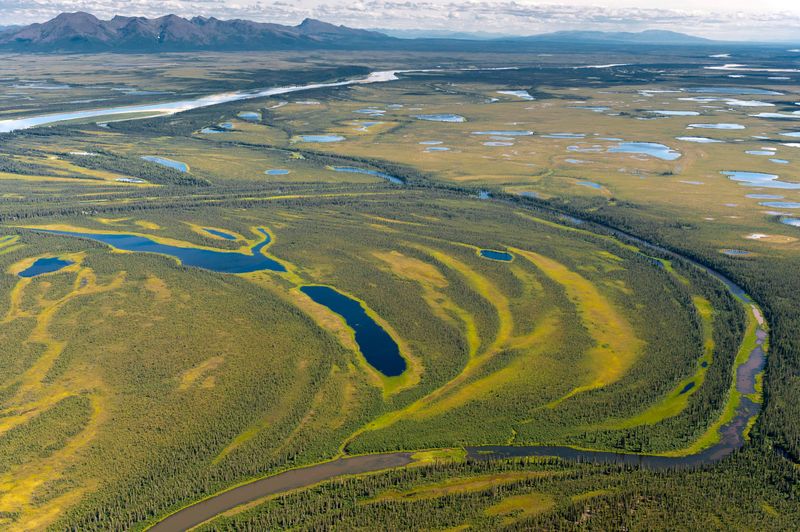Alaska holds some of America’s most breathtaking natural treasures. Wild landscapes stretch for millions of acres, offering views that cameras can barely capture. From towering mountains to massive glaciers, these protected lands showcase nature at its most powerful. Pack your sense of wonder because these eight national parks will leave you speechless.
1. Katmai National Park & Preserve
Brown bears fishing for salmon create one of nature’s most incredible shows. Every summer, massive grizzlies gather at Brooks Falls to catch jumping fish in mid-air.
Photographers travel from around the world to witness this amazing spectacle. The park protects over 4 million acres of wilderness in southern Alaska.
Volcanic landscapes add drama to the scenery, with steaming valleys and pristine lakes. Visitors can safely watch bears from special viewing platforms built just for this purpose.
2. Denali National Park & Preserve
Mount Denali towers 20,310 feet above sea level, making it North America’s tallest peak. Clear days reveal the mountain’s snow-covered summit rising dramatically above the surrounding wilderness.
Caribou, wolves, and Dall sheep roam freely across six million acres of untouched land. The park road winds 92 miles through tundra and forest, offering wildlife viewing opportunities.
Summer brings wildflowers and midnight sun, while winter transforms everything into a frozen wonderland perfect for northern lights viewing.
3. Wrangell–St. Elias National Park & Preserve
America’s largest national park spans an area bigger than Switzerland. Four mountain ranges converge here, creating some of the most rugged terrain on Earth.
Massive glaciers flow between towering peaks, including several mountains over 16,000 feet tall. The park contains the continent’s largest collection of peaks above 14,500 feet.
Historic mining towns like Kennecott tell stories of copper mining adventures from the early 1900s. Visitors can explore abandoned buildings and learn about Alaska’s mining history.
4. Glacier Bay National Park
Tidewater glaciers crash into the ocean with thunderous roars that echo across the water. Massive chunks of ice break off and splash into the bay below.
Humpback whales surface near icebergs, creating magical moments for boat passengers. Sea otters float on their backs while bald eagles soar overhead.
The park showcases how glaciers shape landscapes over thousands of years. Scientists study this area to understand climate change and glacier movement patterns throughout history.
5. Lake Clark National Park & Preserve
Turquoise lakes reflect snow-capped mountains in perfect mirror images. Lake Clark stretches 40 miles through pristine wilderness that few people ever see.
World-class salmon fishing attracts both bears and anglers to crystal-clear streams. Red salmon runs turn rivers into highways of jumping fish.
Active volcanoes dot the landscape, including Mount Redoubt and Mount Iliamna. Small planes provide the only access to this remote paradise, making every visit feel like a true adventure.
6. Kenai Fjords National Park
Fjords carved by ancient glaciers create dramatic coastlines where ice meets the sea. Boat tours navigate between towering cliffs and active glaciers.
Stellar sea lions bark from rocky islands while puffins nest on clifftops. Orcas and harbor seals hunt in the deep, cold waters.
The Harding Icefield covers 700 square miles and feeds over 30 glaciers flowing toward the ocean. Hiking trails lead to overlooks where visitors can see this massive ice sheet stretching to the horizon.
7. Gates of the Arctic National Park & Preserve
No roads, trails, or facilities exist in this true wilderness adventure. Visitors must fly in and rely completely on their outdoor skills.
The Brooks Range creates a natural barrier between Alaska’s interior and the Arctic Ocean. Jagged peaks rise directly from valley floors without foothills.
Caribou migrate through mountain passes in massive herds that stretch for miles. Summer brings 24-hour daylight, while winter offers incredible northern lights displays across star-filled skies.
8. Kobuk Valley National Park
Sand dunes stretch across the Arctic landscape like a desert transplanted to Alaska. Great Kobuk Sand Dunes cover 25 square miles north of the Arctic Circle.
Caribou cross the Kobuk River during their ancient migration routes used for thousands of years. Local communities still depend on this migration for traditional food.
Summer temperatures can reach 80 degrees, making swimming possible in arctic waters. Archaeological sites preserve evidence of human habitation dating back over 10,000 years in this unique environment.








